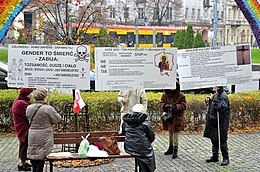
Back الحركة المناهضة للنوع الاجتماعي Arabic Antigenderové hnutí Czech Anti-Gender-Bewegung German Movimiento antigénero Spanish Anti-gender-liike Finnish Antirodni pokret Croatian Հակագենդերային շարժում Armenian 反ジェンダー運動 Japanese 젠더론 반대운동 Korean Anti-genderbeweging Dutch

| Part of a series on |
| Transgender topics |
|---|
|
|

The anti-gender movement is an international movement that opposes what it refers to as "gender ideology",[1] "gender theory",[1] or "genderism",[2] terms which cover a variety of issues,[2] and do not have a coherent definition.[3] Members of the anti-gender movement are stated to primarily include those of the right-wing and far-right political spectrum, such as right-wing populists, social conservatives, and Christian fundamentalists.[4][5] It has been linked to a shift away from liberal democracy and towards right-wing populism.[6] Anti-gender rhetoric has seen increasing circulation in trans-exclusionary radical feminist (TERF) discourse since 2016.[7] Different members of the anti-gender movement variously oppose some LGBT rights, some reproductive rights, government gender policies, gender equality, gender mainstreaming, and gender studies academic departments.[2][8][9] The Canadian Security Intelligence Service has linked the anti-gender movement to the risk of "extreme violence" against the LGBTQI+ community.[10]
The term gender ideology has been described by academics Stefanie Mayer and Birgit Sauer as an "empty signifier",[3] and by Agnieszka Graff as a "great name for all that conservative Catholics despise".[11] The idea of gender ideology has been described by some as a moral panic,[12][13] or a conspiracy theory,[1] as it alleges that there is a secret cabal out to undermine society.[14][15] A report by the European Parliament linked the rise of the anti-gender movement in Europe to disinformation campaigns that are sponsored in large part by Russia.[16]
The movement derives from Catholic theology and can be dated to the late 20th century, but the protests that brought the movement to attention did not start until around 2012–2013.[17] Besides Roman Catholics, anti-gender rhetoric is used by other Christians, Confucians, Hindus, Jews, and Muslims.[18][23] Gender researcher Andrea Pető states that the anti-gender movement is not a form of classical anti-feminism but instead "a fundamentally new phenomenon that was launched to establish a new world order".[24]
- ^ a b c Salvati, M.; Pellegrini, V.; De Cristofaro, V.; Giacomantonio, M. (January 2024). "What is hiding behind the rainbow plot? The gender ideology and LGBTQ+ lobby conspiracies (GILC) scale". British Journal of Social Psychology. 63 (1). Wiley-Blackwell on behalf of the British Psychological Society: 295–318. doi:10.1111/bjso.12678. ISSN 2044-8309. PMID 37606152. S2CID 261062493.
- ^ a b c Kováts 2016, p. 175.
- ^ a b Mayer & Sauer 2017, p. 23.
- ^ "The transnational anti-gender movement in Europe | Gunda-Werner-Institut". Heinrich-Böll-Stiftung. Retrieved 3 September 2022.
- ^ Kováts & Põim 2015, p. 126.
- ^ Walton, Kate. "Opposition to gender equality around the world is connected, well funded and spreading. Here's what you need to know about the anti-gender movement". CNN. Retrieved 29 March 2024.
- ^ Cite error: The named reference
Pearcewas invoked but never defined (see the help page). - ^ Kováts & Põim 2015, p. 11.
- ^ Rawłuszko 2019, p. 2.
- ^ Cite error: The named reference
cbcwas invoked but never defined (see the help page). - ^ Graff 2016, p. 268.
- ^ Careaga-Pérez 2016, p. 251.
- ^ Żuk & Żuk 2019, p. 1.
- ^ Marchlewska et al. 2019, p. 766.
- ^ Zottola, Angela; Borba, Rodrigo (2022). ""Gender ideology" and the discursive infrastructure of a transnational conspiracy theory". Conspiracy Theory Discourses. John Benjamins. pp. 465–488 [473].
- ^ Cite error: The named reference
Disinformationwas invoked but never defined (see the help page). - ^ Kuhar & Paternotte 2017, p. 12.
- ^ Corredor 2019, p. 620.
- ^ Gannon, Thomas M. (July–September 1981). "The New Christian Right in America as a Social and Political Force". Archives de Sciences Sociales des Religions. 26 (52–1). Paris: Éditions de l'EHESS: 69–83. doi:10.3406/assr.1981.2226. ISSN 0335-5985. JSTOR 30125411. Archived from the original on 2 June 2018. Retrieved 7 July 2022.
- ^ Fetner, Tina (August 2001). "Working Anita Bryant: The Impact of Christian Anti-Gay Activism on Lesbian and Gay Movement Claims". Social Problems. 48 (3). Oxford and New York: Oxford University Press on behalf of the Society for the Study of Social Problems: 411–428. doi:10.1525/sp.2001.48.3.411. hdl:11375/21175. ISSN 1533-8533. S2CID 144876642.
- ^ Ibrahim, Nur Amali (October 2016). "Homophobic Muslims: Emerging Trends in Multireligious Singapore". Comparative Studies in Society and History. 58 (4). Cambridge and New York: Cambridge University Press: 955–981. doi:10.1017/S0010417516000499. ISSN 1475-2999. JSTOR 26293235. S2CID 152039212.
- ^ Rehman, Javaid; Polymenopoulou, Eleni (2013). "Is Green a Part of the Rainbow? Sharia, Homosexuality, and LGBT Rights in the Muslim World" (PDF). Fordham International Law Journal. 37 (1). Fordham University School of Law: 1–53. ISSN 0747-9395. OCLC 52769025. Archived from the original on 21 July 2018. Retrieved 30 October 2021.
- ^ [19][20][21][22]
- ^ Pető 2021, p. 42.
© MMXXIII Rich X Search. We shall prevail. All rights reserved. Rich X Search